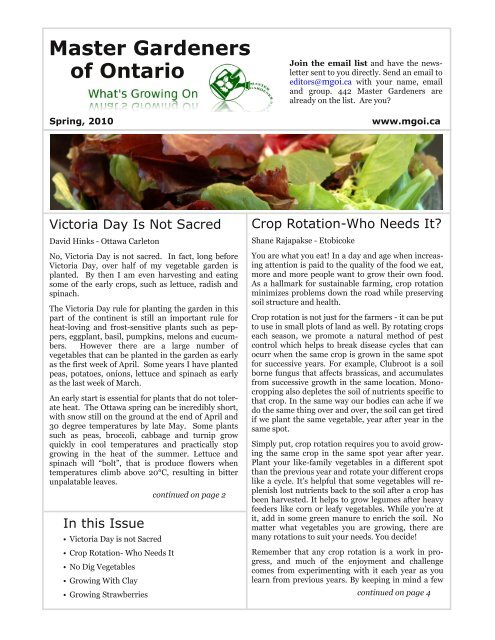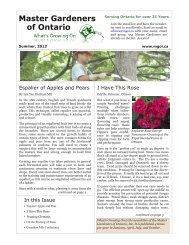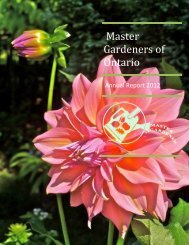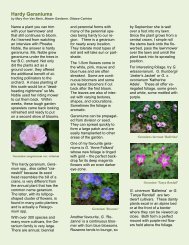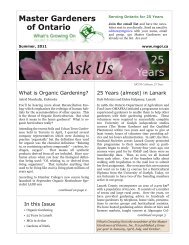Spring 2010 - Master Gardeners of Ontario
Spring 2010 - Master Gardeners of Ontario
Spring 2010 - Master Gardeners of Ontario
Create successful ePaper yourself
Turn your PDF publications into a flip-book with our unique Google optimized e-Paper software.
<strong>Master</strong> <strong>Gardeners</strong><br />
<strong>of</strong> <strong>Ontario</strong><br />
<strong>Spring</strong>, <strong>2010</strong><br />
Victoria Day Is Not Sacred<br />
David Hinks Ottawa Carleton<br />
No, Victoria Day is not sacred. In fact, long before<br />
Victoria Day, over half <strong>of</strong> my vegetable garden is<br />
planted. By then I am even harvesting and eating<br />
some <strong>of</strong> the early crops, such as lettuce, radish and<br />
spinach.<br />
The Victoria Day rule for planting the garden in this<br />
part <strong>of</strong> the continent is still an important rule for<br />
heatloving and frostsensitive plants such as peppers,<br />
eggplant, basil, pumpkins, melons and cucumbers.<br />
However there are a large number <strong>of</strong><br />
vegetables that can be planted in the garden as early<br />
as the first week <strong>of</strong> April. Some years I have planted<br />
peas, potatoes, onions, lettuce and spinach as early<br />
as the last week <strong>of</strong> March.<br />
An early start is essential for plants that do not tolerate<br />
heat. The Ottawa spring can be incredibly short,<br />
with snow still on the ground at the end <strong>of</strong> April and<br />
30 degree temperatures by late May. Some plants<br />
such as peas, broccoli, cabbage and turnip grow<br />
quickly in cool temperatures and practically stop<br />
growing in the heat <strong>of</strong> the summer. Lettuce and<br />
spinach will “bolt”, that is produce flowers when<br />
temperatures climb above 20°C, resulting in bitter<br />
unpalatable leaves.<br />
In this Issue<br />
• Victoria Day is not Sacred<br />
• Crop Rotation Who Needs It<br />
• No Dig Vegetables<br />
• Growing With Clay<br />
• Growing Strawberries<br />
continued on page 2<br />
Join the email list and have the newsletter<br />
sent to you directly. Send an email to<br />
editors@mgoi.ca with your name, email<br />
and group. 442 <strong>Master</strong> <strong>Gardeners</strong> are<br />
already on the list. Are you?<br />
www.mgoi.ca<br />
Crop RotationWho Needs It?<br />
Shane Rajapakse Etobicoke<br />
You are what you eat! In a day and age when increasing<br />
attention is paid to the quality <strong>of</strong> the food we eat,<br />
more and more people want to grow their own food.<br />
As a hallmark for sustainable farming, crop rotation<br />
minimizes problems down the road while preserving<br />
soil structure and health.<br />
Crop rotation is not just for the farmers it can be put<br />
to use in small plots <strong>of</strong> land as well. By rotating crops<br />
each season, we promote a natural method <strong>of</strong> pest<br />
control which helps to break disease cycles that can<br />
ocurr when the same crop is grown in the same spot<br />
for successive years. For example, Clubroot is a soil<br />
borne fungus that affects brassicas, and accumulates<br />
from successive growth in the same location. Monocropping<br />
also depletes the soil <strong>of</strong> nutrients specific to<br />
that crop. In the same way our bodies can ache if we<br />
do the same thing over and over, the soil can get tired<br />
if we plant the same vegetable, year after year in the<br />
same spot.<br />
Simply put, crop rotation requires you to avoid growing<br />
the same crop in the same spot year after year.<br />
Plant your likefamily vegetables in a different spot<br />
than the previous year and rotate your different crops<br />
like a cycle. It’s helpful that some vegetables will replenish<br />
lost nutrients back to the soil after a crop has<br />
been harvested. It helps to grow legumes after heavy<br />
feeders like corn or leafy vegetables. While you’re at<br />
it, add in some green manure to enrich the soil. No<br />
matter what vegetables you are growing, there are<br />
many rotations to suit your needs. You decide!<br />
Remember that any crop rotation is a work in progress,<br />
and much <strong>of</strong> the enjoyment and challenge<br />
comes from experimenting with it each year as you<br />
learn from previous years. By keeping in mind a few<br />
continued on page 4
Page 2<br />
Victoria Day continued from Page 1<br />
Onions and garlic are a special case. They need<br />
cool weather to produce the foliage which will<br />
provide the energy for the bulbs that start forming<br />
when day length begins to shorten in late June.<br />
Garlic is very hardy and I plant it in late October<br />
for the next year’s crop.<br />
Frosthardy vegetables such as lettuce, onions, peas<br />
and spinach can be planted outdoors as soon as the<br />
ground can be worked, <strong>of</strong>ten the first week <strong>of</strong> April<br />
in Ottawa. Semifrosthardy vegetables such as<br />
beets, carrots, chard and potatoes are best planted<br />
in late April or early May as they germinate slowly<br />
in cold soil.<br />
So what happens if the weather turns really nasty?<br />
One year I had peas that were about 10 cm high<br />
when we had a late snowfall <strong>of</strong> 20 cm. Once the<br />
snow was melted the peas were still growing with<br />
no problem. I have had potato foliage frozen to<br />
ground level – it didn’t take them long to spring<br />
back with fresh growth from the roots. Onions and<br />
spinach take frost in their stride.<br />
Some gardeners try to get a head start on the season<br />
with relatively tender plants such as tomatoes.<br />
While gardening is not a competitive sport, there<br />
are those who take a certain amount <strong>of</strong> pride in<br />
having the first juicy red tomato on the block. I<br />
may plant a few tomatoes two or three weeks before<br />
Victoria Day but I spread my risks by planting<br />
the main crop when it is warmer.<br />
Raised beds and well drained soil assist an early<br />
start by warming up much faster. In order to determine<br />
if soil is workable, take a handful and<br />
squeeze – if it stays together in a ball it is still too<br />
wet, if it crumbles it is ready. Time to get out and<br />
get planting!<br />
President: James Lee – president@mgoi.ca<br />
Treasurer: Wendy Fletcher – treasurer@mgoi.ca<br />
Corporate Secretary: Linda Hugli – secretary@mgoi.ca<br />
Directors:<br />
Zone 1: Ralph Bullough – zone1@mgoi.ca<br />
Zone 2: Linda Hugli – zone2@mgoi.ca<br />
Zone 3: vacant<br />
Zone 4: Ann Ironside zone4@mgoi.ca<br />
Zone 5: June Streadwick – zone5@mgoi.ca<br />
MGOI Board <strong>of</strong> Directors<br />
<strong>Master</strong> <strong>Gardeners</strong> <strong>of</strong> <strong>Ontario</strong> <strong>Spring</strong> <strong>2010</strong><br />
No Dig Vegetables<br />
Editors<br />
Digging a garden every year, is not practiced by all<br />
vegetable gardeners. Growing numbers employ “no<br />
dig” methods. In the 70’s Ruth Stout wrote articles<br />
about growing vegetables under a thick layer <strong>of</strong><br />
straw. She never dug, watered or used harsh chemicals.<br />
She just planted and picked. There is a<br />
UTube video about her which you should watch because<br />
it’s a hoot. A more recent proponent, Patricia<br />
Lanza in her books on “lasagna gardening” recommends<br />
layering various types <strong>of</strong> organic matter in<br />
raised beds. She suggests growing vegetables year<br />
after year, never digging or walking on the beds<br />
and adding new organic matter to the top. Permaculture<br />
enthusiasts use similar techniques. Mel<br />
Bartholomew in his popular square foot gardening<br />
books even recommends ignoring the native soil<br />
and planting in his growing medium in raised beds<br />
above the soil. These no dig methods promise high<br />
yields, less work, and natural management <strong>of</strong> insects<br />
and diseases.<br />
Net Resouces<br />
Editors<br />
The net is full <strong>of</strong> great sources <strong>of</strong> vegetable gardening<br />
information. It is also full <strong>of</strong> information<br />
which is not very useful so some patience is needed<br />
while looking. Videos are available for those with a<br />
high speed connection. For example, the Royal<br />
Horticultural Society <strong>of</strong> the UK has a number <strong>of</strong><br />
good videos on vegetables. Alan Titmarsh has also<br />
created a number <strong>of</strong> videos for the BBC on gardening.<br />
Garden Girl also has useful videos. The Peterborough<br />
Group has a number <strong>of</strong> basic fact sheets<br />
on vegetable growing on their website.<br />
Zone 6: Valerie Liney – zone6@mgoi.ca<br />
Zone 7: Jeanne Stoness – zone7@mgoi.ca<br />
Zone 8: Kelly Noel – zone8@mgoi.ca<br />
Zone 9: Don Nicholson – zone9@mgoi.ca<br />
Zone 10: Vacant<br />
Zone 11: John Craw zone11@mgoi.ca<br />
Newsletter: Dianne & Gary Westlake – editors@mgoi.ca<br />
MG Listserve: Kelly Noel – listcoordinator@mgoi.ca<br />
OMAFRA Representative: Helen Scutt – omafra@mgoi.ca<br />
Provincial Administrator:Charlotte Vorstermans – info@mgoi.ca 113 Mill Street, Creemore, ON L0M 1G0<br />
Director at Large: Charlie Dobbin – charlied@rogers.com<br />
Landscape <strong>Ontario</strong> Rep: Denis Flanagan – dflanagan@landscapeontario.com
<strong>Master</strong> <strong>Gardeners</strong> <strong>of</strong> <strong>Ontario</strong> <strong>Spring</strong> <strong>2010</strong> Page 3<br />
Growing with Clay<br />
Tony Rudd London/Middlesex<br />
My Dad’s vegetable plot was heavy clay. It was difficult<br />
digging in the winter and in summer it dried<br />
bone hard. It occupied his mind constantly as to<br />
how he was going to overcome it. When he finally<br />
gave up the plot after 20 years, it was not much<br />
better than when he had started. Yet year after<br />
year we had a plentiful supply <strong>of</strong> fresh fruit and<br />
vegetables.<br />
Clay is an omnibus term for soils with very fine<br />
particle sizes. They come in a number <strong>of</strong> colours<br />
red, blue, yellow and white for instance. Some<br />
clays are sticky, some slippery. Others form deep<br />
cracks when dry. All clays can be a problem for<br />
the home vegetable gardener. Because they are <strong>of</strong><br />
fine particle size, they hold water and do not drain<br />
easily. There is usually a later start in the spring<br />
while the soil dries down. Conversely, in the later<br />
stages <strong>of</strong> a drought, clay soils hang on to water<br />
and plants have to exert enormous pressure to be<br />
able to extract water from drying clay soils.<br />
As well as holding water, clay soils hold on to<br />
plant nutrients. If you can once overcome the<br />
drawbacks <strong>of</strong> clay soils, you will have a very fertile<br />
and productive garden.<br />
Organic matter is a remedy for many soil problems,<br />
including clay. As vegetable matter decomposes<br />
in soil it releases substances that form<br />
aggregates with the clay particles. This opens up<br />
more and bigger spaces in the soil allowing freer<br />
movement <strong>of</strong> air and water. This allows better<br />
drainage and encourages root growth. Particles <strong>of</strong><br />
organic matter lodge between soil particles and<br />
Continued on page 4<br />
Mystery Plant<br />
Do you know this<br />
plant? The answer<br />
will be revealed next<br />
issue. Contact<br />
editors@mgoi.ca<br />
with your guess.<br />
The mystery plant was a mushroom called dog<br />
stinkhorn Mutinus caninus. Yes we know it's not<br />
a plant but we could not resist using something<br />
this strange. Thanks to Diane Vaughan for the<br />
suggestion. Catherine Kavassalis, Oakville was<br />
first, honorable mention to Elizabeth Stewart,<br />
Toronto, Janet Trezise. LSSMG, Lois Bennett –<br />
Tweed/Quinte, Erika North – Thunder Bay.<br />
MGs in Action<br />
Toronto <strong>Master</strong> <strong>Gardeners</strong> and TBG<br />
Launch New Urban Vegetable Gardening<br />
Programme<br />
The Toronto <strong>Master</strong> <strong>Gardeners</strong> have partnered<br />
with the Toronto Botanical Garden to develop a<br />
new programme to address the challenges faced by<br />
both land and balcony city food growers.<br />
Sponsored by the McLean foundation, the series <strong>of</strong><br />
five weekend workshops will take new gardeners<br />
through all the stages <strong>of</strong> successful and sustainable<br />
gardening, from initial planning to harvesting and<br />
preparing for the next growing season. Suitable for<br />
those with small balconies as well as those with<br />
large properties, each class will have both outdoor<br />
and indoor components and each student will<br />
leave with a container planted with seasonally appropriate<br />
vegetables. Topics include: Veggies in<br />
the City: Getting Back to Basics, Getting Started:<br />
<strong>Spring</strong> Crops and Veggie Garden Designs, Tending<br />
Your Plot – Summer Crops and Growing Techniques,<br />
The Harvest: Enjoying the Fruits <strong>of</strong> Your<br />
Labour, Planning for Next Year: Storing, Seed Saving<br />
and Overwintering. Interested gardeners may<br />
register for individual classes or for sets <strong>of</strong> 3 or 5 at<br />
discounted rates. More information is available at<br />
www.torontobotanicalgarden.ca.<br />
Garden Design in Guelph<br />
"Digging In – Well, Well" – Guelph &Wellington<br />
County MG have committed to working with the<br />
City <strong>of</strong> Guelph on designing and planting a garden<br />
on one <strong>of</strong> the city's "Well Houses" properties. The<br />
City is interested in saving on lawn care and showing<br />
citizens garden alternatives. It is just a beginning,<br />
but has the potential <strong>of</strong> turning into a<br />
demonstration garden and <strong>of</strong> also beautifying our<br />
community!<br />
Seedy Saturday in London
Page 4<br />
Milestones<br />
New MGiTs<br />
Etobicoke – Sharon Burge, Vena Eaton, Louise Grech,<br />
Mary Ellen Mathison, Lauren Nurse, Ariela Weisfeld<br />
Halton – Jane Leonard<br />
Niagara – Pam Coring, Julia Dodge, Sue Gemmill, Julie<br />
Makin, Stephanie McClure<br />
Ottawa Carleton – Tom Marcantonio, Valerie Proctor<br />
Toronto – Joanna Blanchard, Sheila Boudreau, Jackie<br />
Campbell, Tina Cesaroni, Connie Foster, Abdullah<br />
Hamidi, Verna Leader, Linda Lynott, Cathy<br />
McCartney, Gwen Rattle, Emma Rooney, Elizabeth A.<br />
Stewart, Billy To, Maureen Webber, Joan Weed,<br />
Bonnie West, Dianne White<br />
New MGs<br />
Etobicoke – Lillian Brown; Anna Arabczuk<br />
Halton – June Wright<br />
LSSMG – Terri Briggs, Lynne Marie Sullivan<br />
Ottawa Carleton – Josie Pazdzior<br />
Stratford – Carolyn Rastorfer<br />
Sudbury (Espanola) – Irene Granger<br />
<strong>Master</strong> <strong>Gardeners</strong> <strong>of</strong> <strong>Ontario</strong> <strong>Spring</strong> <strong>2010</strong><br />
Clay continued from page 3 Crop Rotation continued from page 1<br />
hold them apart. Organic matter such as compost<br />
also releases plant nutrients to the soil.<br />
Just before first frost, take a spade and dig a furrow.<br />
Into the trench put as much compost and or<br />
manure as you can spare. Dig the next furrow burying<br />
the compost and again fill the trench with more<br />
compost etc. Do not break up the clods. Let the soil<br />
freeze in that condition. If you want to put compost<br />
on top, do so after the soil has frozen. Frost breaks<br />
concrete and will also break clay.<br />
Next spring, when the soil has dried down, work<br />
the surface with a rake prior to planting. Avoid unnecessary<br />
traffic to prevent compaction. It will be<br />
necessary to repeat it every year until there is<br />
enough organic matter to make a permanent difference.<br />
Radishes All Summer Long<br />
Robert Pavlis – Guelph and Wellington County<br />
As soon as it gets warm, radishes get woody and<br />
flower. This is great news. The flowers turn into<br />
seed pods not unlike peas. These seed pods are<br />
great eating and taste just like radish roots. Pick<br />
them young while they are tender.<br />
things, it will make it much easier to work out a<br />
suitable rotation for you.<br />
• Know botanical names <strong>of</strong> your vegetables and<br />
group vegetables from the same family together<br />
• Explore the internet there are a wealth <strong>of</strong> resources<br />
awaiting your discovery<br />
• Keep a notebook handy to keep accurate records<br />
and any observations<br />
• Grow green manure they enrich the soil like<br />
essential nutrients for the soul<br />
• Alternate deeprooted and shallowrooted crops<br />
to promote a balanced draw<br />
• Leafy vegetables generally use a lot <strong>of</strong> nitrogen <br />
plant soil builders prior<br />
Some basic types <strong>of</strong> groupings that may work for<br />
you include: heavy feeders (broccoli, lettuce, tomatoes,<br />
eggplant, corn, squash); light feeders<br />
(carrots, turnips, sweet potatoes, peppers, garlic,<br />
onions, chives); nitrogen fixing (soil builders –<br />
green beans, lima beans, peas, soybeans); green<br />
manures (clover, vetch, alfalfa, rye, buckwheat).<br />
Toronto – Linda Boyko, Veronica Callinan, Judy Clarke,<br />
Sharron Colbert, Lori Di Monte, Jean Gardiner,<br />
Maureen Hulbert, Susan Lipchak, Lesli Musicar, Dawn<br />
Scott and Claire Trepanier.<br />
5 Years<br />
Kitchener MG – Kim Ball, Ken McRae, Gary R. Miller, Liz<br />
Stacey<br />
OttawaCarleton – Rebecca Last, Mary Ann Van Berlo<br />
Toronto – Daryl Bessell, Jane Bridgeman, Pat de Valence,<br />
Ruthanne Stiles<br />
10 Years<br />
Kitchener – Sharon Campbell.<br />
Niagara – June Streadwick<br />
Ottawa Carleton – Bob Duff, Edythe Falconer<br />
Toronto – Peter Cox, Ellen Farrelly, Lorraine Flanigan,<br />
Catherine Peer, Lucy Van Wyk<br />
15 Years<br />
Niagara – Joan Jones<br />
Toronto – Sonia Leslie<br />
20 Years<br />
Kitchener – Huguette Meinzinger,<br />
Toronto – Mary Mordy
<strong>Master</strong> <strong>Gardeners</strong> <strong>of</strong> <strong>Ontario</strong> <strong>Spring</strong> <strong>2010</strong> Page 5<br />
Growing Strawberries<br />
Laura Stockdale, Peterborough<br />
The strawberry is a<br />
very popular fruit for<br />
home gardens and can<br />
be grown anywhere in<br />
<strong>Ontario</strong>. It is the first<br />
fruit to ripen and by a<br />
selection <strong>of</strong> “Junebearing”<br />
varieties, ripe<br />
fruit can be obtained from midJune to late July,<br />
the year after planting. Nothing beats eating a fresh<br />
strawberry picked either <strong>of</strong>f your own plants or at a<br />
local pickyourown farm. With some planning and<br />
preparation now, you can be ready to plant early<br />
next spring. Strawberries do not like wet feet and<br />
require full sun. If soils tend to be poorly drained,<br />
planting on a raised ridge (46 inches) is helpful to<br />
keep the root systems from becoming water logged<br />
and to prevent plants from smothering from ice in<br />
the winter. Strawberries should not follow crops <strong>of</strong><br />
peppers, raspberries, potatoes, tomatoes, or eggplants.<br />
This precaution avoids serious root diseases<br />
such as verticillium wilt and black root rot. All perennial<br />
weeds and grasses should be destroyed by<br />
Events<br />
April 9 (evening), 10 and 11 Peterborough Garden<br />
Show at the Evinrude Centre, 911 Monaghan Rd.<br />
vendors, speakers, demonstrations, floral<br />
competition. $5 www.peterboroughgardens.ca<br />
April 10 at 10:00 a.m. at Knox Presbyterian Church, 55<br />
Hincks Street, St. Thomas – The Elgin County<br />
<strong>Master</strong> <strong>Gardeners</strong> present 'Plant Pollinators'.<br />
Door prizes and Annual Plant Auction. Bring a<br />
bag lunch. Refreshments will be provided.<br />
$5.00. Contact Helen (519) 7739621, Diane<br />
(519) 6333213 or Richard (519) 6333939.<br />
April 23 to 25; Friday and Saturday – 10 a.m. to 8 p.m.,<br />
Sunday – 10 a.m. to 6 p.m. Royal Botanical<br />
Gardens. http://www.rbg.ca/pages/GardenShow.html<br />
April 14 at 7:00 p.m. – Four Partners Event –"Healthy<br />
Landscapes", SpeakerMartin Galloway –<br />
University <strong>of</strong> Guelph Arboretum Centre. Free.<br />
April 17 at 2:00 p.m. – “Bees in the Garden” Suzanne<br />
Zacharczyk, and May 24 at 2:00 p.m. – “The<br />
Low Maintenance Approach to Garden Design”<br />
with Marsha Gettas at Montgomery Inn, 4709<br />
Dundas St. W., Etobicoke. Presented by<br />
Etobicoke MGs. Pay what you can.<br />
April 20 at 7:00 pm at Eising Greenhouses and Garden<br />
Centre, 814 Cockshutt Road, Simcoe – Norfolk<br />
cultivation the previous year to planting. Manure or<br />
compost can be incorporated the fall previous to<br />
planting to add organic matter and fertility at a rate<br />
<strong>of</strong> 23 bushels per 100 square feet. A soil test is recommended<br />
to determine fertility and pH. Strawberries<br />
prefer a slightly acidic soil with a pH <strong>of</strong><br />
6.36.5 for best growth.<br />
Laura is an MG who runs a upick strawberry<br />
farm. See the website for the full article<br />
Etobicoke MGs enjoy well deserved champagne<br />
for passing the Certification Exam. From left to<br />
right: Lillian Brown, Anna Arabczuk, Bev Sutton,<br />
Karen Klar, Marcia Barron and Anne Grgic.<br />
County MGs present "Pushing the Zones"<br />
–speaker Kevin Kavanagh, owner <strong>of</strong> South<br />
Coast Gardens. Free. norfolkmg@yahoo.com<br />
May 15 at the Newmarket Church <strong>of</strong> Christ, 230 Davis<br />
Drive, 9:00 a.m. LSSMG Plant Sale.<br />
May 15 – Guelph and Wellington County MG. Plant<br />
Sale at the Turf Grass Institute on Victoria Road<br />
South in Guelph<br />
May 22 at 8:30 a.m., Prince Edward County <strong>Master</strong><br />
<strong>Gardeners</strong>' Plant Sale, Giant Tiger parking lot,<br />
Main Street, Picton. Contact: Virginia Mitchell<br />
VKMitchell@persona.ca<br />
June 2 – 10:00 a.m. to 7:00 p.m. and June 3 from 10:00<br />
a.m. to 4:00 p.m. Flower Show at the Royal<br />
Botanical Gardens, 680 Plains Road W.,<br />
Burlington. Admission to the show is included<br />
with admission to RBG. Demonstrations will be<br />
held daily at 10:00 a.m. and 2:00 p.m.<br />
June 19 and June 20 – 11 a.m. to 4 p.m. Through the<br />
Garden Gate: The Beaches Tickets are $40.00.<br />
For more information: 4165510241 or<br />
ttgg@torontobotanicalgarden.ca<br />
July 17 – 18 – M.G.O.I. Summer Workshop at the<br />
Niagara Parks School <strong>of</strong> Horticulture. $250.<br />
For more information go to www.mgoi.ca For<br />
registration contact June Streadwick at<br />
streadwick@sympatico.ca or at 9059346137.


